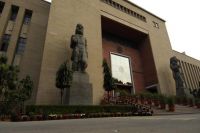
RBI’s Financial Stability Report warns that financial institutions in India are under severe strain in the background of declining asset quality. The Report analyses various financial stability risks in every six months. In its December 2015 update it highlights worsening financial health of Public Sector Banks.
Most of the financial stability indicators are worsening for Scheduled Commercial Banks (SCBs). Within the SCB category, the plight of Public Sector Banks (PSBs) is to be addressed soon.
Two major banking sector indicators – Capital to Risk-weighted Assets Ratio (CRAR) and Gross NPAs have fallen for all categories of SCBs during 2015.
Risks to the banking sector increased since the previous FSR, on account of deteriorating asset quality, lower soundness and sluggish profitability.
Default of by the large borrowers is a notable factor for worsening asset quality. “…the GNPA ratios of large borrowers among PSBs from 6.1 per cent in March 2015 to 8.1 per cent in September 2015, led to an increase in the GNPA ratio of the banking system.”
Outside the commercial banking system, the asset quality of both scheduled urban co-operative banks (SUCBs) as well as Non-Banking Financial Companies (NBFCs) deteriorated.
The capital to risk-weighted assets ratio (CRAR) of SCBs at the system level declined to 12.7 per cent from 13.0 per cent between March and September 2015.
There are two major external factors that may bring negative effects on the domestic financial system- the declining growth in China and monetary policy stance of the advanced countries.
At the same time, the Report concludes that India can withstand such events because of the resilient domestic economy.
*********











